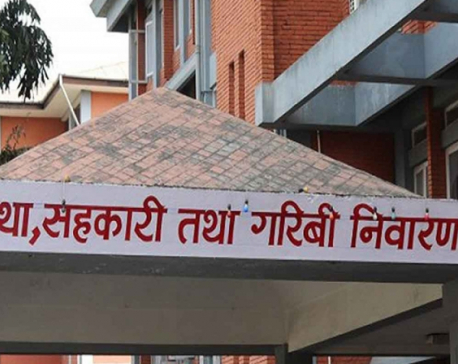
OR
New co-ops regulations lay out forceful merger provision
Published On: April 23, 2019 08:00 AM NPT By: Sagar Ghimire | @sagarghi
KATHMANDU, April 23: The government has set standards on registration of new savings and credit cooperatives amid concerns about their growing concentration in urban areas.
According to the new regulation on cooperatives that was recently approved by the cabinet, registration of cooperatives will be based on population of local units. The new regulations, which come in line with the Cooperatives Act 2017, also has a provision that requires existing cooperatives that operate against the standards to go for forceful merger.
As per the new regulation, the government will allow registration of only one cooperative per 5,000 people in a ward of metropolitan and sub-metropolitan cities. Similarly, there will be one cooperative per 2,000 people in municipal area whereas the government will issue license to only one cooperative for every 500 people in rural municipality, according to the new regulations.
The cooperative registrar at the Department of Cooperatives will give priority to the first application if there are multiple applications for registration of savings and credit cooperatives.
Observers say that most of these savings and credit cooperatives have sprouted up in urban areas in recent years. The surge in savings and credit cooperatives have also been attributed to weak corporate governance and internal control in many institutions, landing over 150 such institutions, including Oriental Cooperatives, into troubles. Due to anomalies and lack of corporate governance in those cooperatives, deposits worth over Rs 14 billion of public are at stake.
However, the department has issued a moratorium for licensing of cooperatives in urban areas.
“The regulation to set standards for registration based on population is aimed at preventing risks of high concentration of savings and credit cooperatives in urban areas and encourage the establishment in remote areas where no such institution are preset so far,” Narayan Prasad Aryal, an information officer for the department, told Republica.
As of mid-December 2017, there were a total of 34,512 cooperatives across the country. Among them, the number of savings and credit cooperatives is the highest. According to the data of the Department of Cooperatives, 13,578 savings and credit cooperatives in operation have mobilized a total of Rs 217.49 billion in deposits and extended loans worth Rs 179.88 billion.
REGULATION PROVISIONS FORCEFUL MERGER
The new regulation also lays out provision of merger of such institutions if the number of cooperatives is higher than the limit. The new regulation has set a three-year deadline to reduce the number of cooperatives to ensure implementation of the standards. “If the number of cooperatives is higher than the standards laid out in the regulations, the regulation has made merger between cooperatives within three years a compulsion,” said Aryal.
Leaders of cooperative sector, however, call for incentives and subsidies to encourage merger of cooperatives. “It would have been easier for implementation of merger if incentives or other facilities were offered to institutions pursuing a marriage like in the banking sector,” DB Basnet, the chairperson of Nepal Federation of Savings and Credit Cooperatives Unions Ltd (NEFSCUN), told Republica.
He is of the view that merger policy could help to strengthen corporate governance and internal control in cooperatives. Based on the standards set in the regulations, he said that the number of cooperatives in reality could go up. “The standards based on the population mean indicate that the number of cooperatives in Kathmandu is high. But, this will pave the way for registration of more cooperatives outside Kathmandu Valley,” he added.
You May Like This

Translate words into real action
Acknowledging the failure of the government to address the grievances of a large number of victims of cooperatives even after... Read More...

Govt working at snail’s pace to address the issue of problematic cooperatives
KATHMANDU, Dec 28: The government has asked the problematic cooperatives to submit their work plan to return the money of... Read More...

Govt refuses hiking reference interest rate on loan issued by cooperatives
KATHMANDU, Jan 9: The government has ruled out raising the reference interest rate for cooperatives at a time when the cooperatives... Read More...

Just In
- World Malaria Day: Foreign returnees more susceptible to the vector-borne disease
- MoEST seeks EC’s help in identifying teachers linked to political parties
- 70 community and national forests affected by fire in Parbat till Wednesday
- NEPSE loses 3.24 points, while daily turnover inclines to Rs 2.36 billion
- Pak Embassy awards scholarships to 180 Nepali students
- President Paudel approves mobilization of army personnel for by-elections security
- Bhajang and Ilam by-elections: 69 polling stations classified as ‘highly sensitive’
- Karnali CM Kandel secures vote of confidence


















Leave A Comment